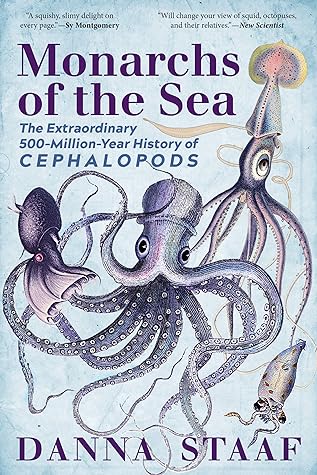More on this book
Kindle Notes & Highlights
Squid mantles contain the world’s largest nerve cells, which squid have used for millennia to jet away from predators and which scientists have used for eight decades to elucidate pretty much all of modern neuroscience.
The chameleon’s skin-changing system relies on hormones, which have to be manufactured in the brain and then distributed around the body in the bloodstream. The cephalopod’s system is under direct nervous control. Each spot of color (of which there can be more than two hundred in a square millimeter of skin) is controlled by tiny nerves that connect straight back to the brain. “Rapid” color change in chameleons takes a couple of minutes;12 changes in squid skin have been clocked at up to four per second.13
Calcium is life’s preferred material for hardening both external and internal skeletons—it shows up in bones as calcium phosphate.
descendants of the descendants used a thin tube of flesh, stretching back through every chamber in the shell, to extract liquid and replace it with gas. The extra buoyancy lifted both shell and animal up into the water.
When I first learned about the buoyancy of nautiluses, I assumed that they actively pumped gas into their shells, like a balloonist filling up for a flight. Had I lived in the nineteenth century, this notion would have been in line with all the available scientific speculation. However, decades of careful observation in the twentieth century revealed that the nautilus concerns itself only with pumping water out of its shell. Where the water used to be, gas slowly seeps in, but this is simply an accident that illustrates the difficulty of maintaining a vacuum.
A curious effect of this process is that cephalopods cannot breathe without also moving.
Fish armor was at least articulated, able to bend and move. Cephalopod shells were less armor and more mobile bomb shelter.
Regardless of size differential or mating tactic, females of all the modern cephalopod species that have been studied collect and store sperm from multiple males before laying their eggs.
Sadly, they can’t help you decode the secret messages of cuttlefish, which have the ability to perform a sort of double-talk with their skin, maintaining color camouflage for the benefit of polarization-blind predators while flashing polarized displays to their fellow cuttlefish.
Dirk Fuchs and his colleague Yasuhiro Iba have named the pen “one of the key innovations responsible for the most powerful mode of jet propulsion among cephalopods.”22
octopuses have sessile suckers sitting flat on the skin, while squid have pedunculate suckers attached to stalks like little mushrooms.
Once Antarctica chilled enough for the seawater around it to start freezing, a strange chemical fact came into play: there is no such thing as saltwater ice. When seawater freezes, it leaves its salt behind. The water around the forming ice thus becomes even saltier—and saltier water can stay liquid at colder temperatures. So whenever a bit of seawater freezes, it creates two things: freshwater ice and extremely salty, extremely cold liquid water. The saltier and colder water becomes, the heavier it gets, so this frigid saltwater sinks to the bottom of the sea, following the dips and ridges of
...more
Echolocation works best when the echoes can bounce off hard surfaces. The softer the target, the more difficult it is to locate—in the extreme case, a jellyfish would be virtually invisible (or more properly, inaudible).
The critical component of high-quality octopus fossils seems to be phosphate, a chemical that occurs naturally in seawater, and in living tissue as a building block of DNA and of energy-carrying molecules. When conditions are right, the soft tissues of a dead animal can be quickly replaced with the mineral calcium phosphate. Such phosphatic fossilization sometimes preserves detail down to the level of single cells.
Ammonia is a tiny bit lighter than sodium, so saltwater made with ammonium chloride is less dense than ordinary seawater—in other words, it’s buoyant. Because the difference is so slight, huge amounts of ammonium chloride are needed to create significant buoyancy, and indeed some ammoniacal squid (as they are called) devote more than half of their mass to ammonia-saltwater.
It’s not unusual to overhear people guess or assume that the giant Pacific octopus is endangered, simply because it’s large and beautiful (a tragic reflection on what it means to be a large, beautiful species in the Anthropocene).
Already quick to mature, coleoid cephalopods could be growing even more quickly thanks to global warming.
“So long and thanks for removing all the fish!”
As you might imagine, transparent organisms are great for doing science. Every step of the animal’s development is plain to see, and specific features like the growth of a particular neuron can be easily tracked with fluorescent markers (not the kind you’d highlight a textbook with, but the molecular kind). It’s even possible to shine light into transparent organisms to control their neurons, as long as you’ve spliced in a light-sensitive gene. “You can stop and start a heartbeat with light,” says Edsinger-Gonzales. “You can make worms crawl.”5


